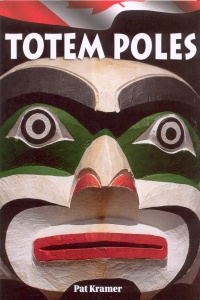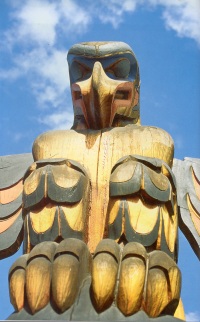| ________________
CM . . .
. Volume XV Number 10. . . .January 9, 2009 
 |
Totem Poles.
Pat Kramer.
Vancouver, BC: Heritage House, 1998/2008.
112 pp., pbk., $19.95.
ISBN 978-1-894974-44-8.
Subject Headings:
Totem poles-British Columbia-History.
Indians of North America-Material culture-British Columbia.
Indian wood-carving-British Columbia.
Indians of North America-British Columbia-Antiquities.
British Columbia-Antiquities.
Grades 9 and up / Ages 14 and up.
Review by Gillian Richardson.
***½ /4
|
| |
|

excerpt:
Tall freestanding poles are usually commissioned to mark a special occasion and require years of planning. The design is conceived through a collaboration process under the direction of one person, and the pole is carved by a team of apprentices under a master carver. The concepts behind tall totem poles are important, and there are layers of meaning intermingled among the figures. Status among totem poles is determined by the reputation of the chief carver, the number of consultations held with elders, and the size of the ceremony accompanying the raising. The first freestanding poles were probably made by the Tsimshian people along the Nass and Skeena Rivers.
You've likely admired totem poles, but have you thought about the meaning of the figures carved on them, about the stories they tell or about the people of the Pacific Northwest who have shared their history for generations through this art form?
Totem Poles, first published in 1998, is a thoroughly researched reference and guidebook to totem poles. It describes the origin and history of the carved poles first documented by an artist on Captain James Cook's third voyage in 1778. The impact of exploration of the northwest, including smallpox and missionary work, on development of the art is seen in laws forbidding display, totems removed for museum collections around the world, a 50 year period of dormancy in carving, and a renaissance after 1949 that is sustained by the resurgence in aboriginal pride, and
tourist appeal.
 A second chapter offers details about the symbols carved on the cedar poles and the stories they represent as an expression of culture and heritage. The figures are further explained in a third chapter. They include animal and human forms, as well as astronomical images that are part of tribal legends. A list of poles and collections from Seattle, WA, to Juneau, AK, will help the reader locate and view some of the best authentic totems: e.g. the world's tallest totem is found at Alert Bay.
A second chapter offers details about the symbols carved on the cedar poles and the stories they represent as an expression of culture and heritage. The figures are further explained in a third chapter. They include animal and human forms, as well as astronomical images that are part of tribal legends. A list of poles and collections from Seattle, WA, to Juneau, AK, will help the reader locate and view some of the best authentic totems: e.g. the world's tallest totem is found at Alert Bay.
Generously illustrated with excellent photos (some historic) mostly by author/photographer Pat Kramer, the book includes maps (totem people, pole locations), detailed guides to variations in style and types of figures, and a step by step account of carving and raising. Several traditional stories shown in totem art are included.
Sophisticated in tone and vocabulary, with small type, this guidebook will attract adult readers in particular. It might find a place in high school library collections as a reference tool. It is a valuable record of totem art presented in an appealing and readable book.
Highly Recommended.
Gillian Richardson, a freelance writer and former teacher-librarian, lives in BC.

To comment
on this title or this review, send mail to cm@umanitoba.ca.
Copyright © the Manitoba Library Association. Reproduction for personal
use is permitted only if this copyright notice is maintained. Any
other reproduction is prohibited without permission.
NEXT REVIEW |
TABLE OF CONTENTS FOR THIS ISSUE
- January 9, 2009.
AUTHORS |
TITLES |
MEDIA REVIEWS |
PROFILES |
BACK ISSUES |
SEARCH |
CMARCHIVE |
HOME |

 A second chapter offers details about the symbols carved on the cedar poles and the stories they represent as an expression of culture and heritage. The figures are further explained in a third chapter. They include animal and human forms, as well as astronomical images that are part of tribal legends. A list of poles and collections from Seattle, WA, to Juneau, AK, will help the reader locate and view some of the best authentic totems: e.g. the world's tallest totem is found at Alert Bay.
A second chapter offers details about the symbols carved on the cedar poles and the stories they represent as an expression of culture and heritage. The figures are further explained in a third chapter. They include animal and human forms, as well as astronomical images that are part of tribal legends. A list of poles and collections from Seattle, WA, to Juneau, AK, will help the reader locate and view some of the best authentic totems: e.g. the world's tallest totem is found at Alert Bay.